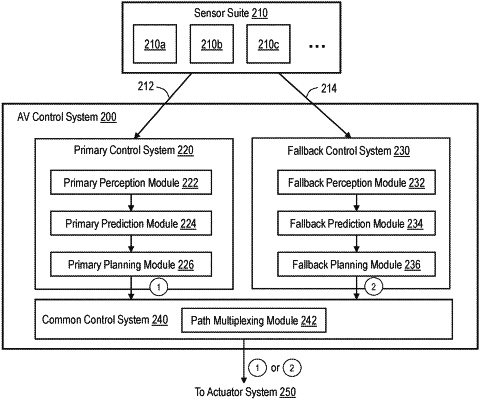| CPC B60W 60/0027 (2020.02) [B60W 30/09 (2013.01); B60W 50/023 (2013.01); G06N 5/01 (2023.01); B60W 2554/4044 (2020.02); B60W 2555/60 (2020.02)] | 16 Claims |

|
1. A method comprising:
collecting sensor data generated by one or more sensors of a vehicle;
detecting, by a fallback control system of the vehicle based on the sensor data, an imminent collision between the vehicle and an object in an environment of the vehicle using a first process different from a second process of a primary control system of the vehicle,
wherein the detecting of the imminent collision is performed repeatedly,
wherein the first process and the second process are associated with at least one of a perception or a prediction,
wherein the first process includes: predicting a trajectory of the vehicle and a trajectory of the object in the environment of the vehicle is at least partially overlapping, and
classifying the object to determine an object type of the object,
determining, by the fallback control system and based on the object type of the object, whether to suppress a trigger, which indicates the detected imminent collision, from being transmitted to the primary control system;
suppressing transmission of the trigger when the object type of the object corresponds to an assumption that the object is observant of a traffic rule that would result in avoidance of the detected imminent collision between the vehicle and the object;
transmitting, by the fallback control system to the primary control system, the trigger when the object type of the object does not correspond to the assumption that the object is observant of the traffic rule that would result in avoidance of the detected imminent collision between the vehicle and the object;
wherein the transmitting of the trigger is further based on a number of consecutive detected imminent collisions satisfying a threshold number of consecutive detections;
adjusting the threshold number of consecutive detections for determining whether to transmit the trigger based on the object type of the object; and
determining, by the primary control system based on the sensor data, using the second process a path for the vehicle in the environment, wherein the second process utilizes machine learning to determine the path, and
wherein the primary control system and the fallback control system operate within a multi-layer autonomous vehicle software stack that autonomously controls operation of the vehicle.
|